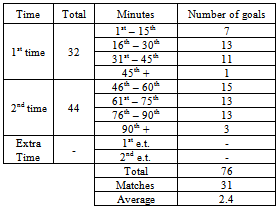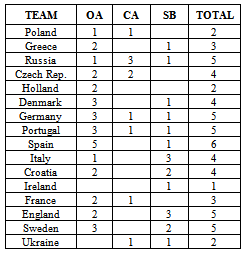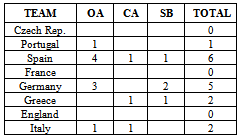-
Paper Information
- Previous Paper
- Paper Submission
-
Journal Information
- About This Journal
- Editorial Board
- Current Issue
- Archive
- Author Guidelines
- Contact Us
International Journal of Sports Science
p-ISSN: 2169-8759 e-ISSN: 2169-8791
2013; 3(4): 102-106
doi:10.5923/j.sports.20130304.02
Euro 2012: Analysis and Evaluation of Goals Scored
Werlayne S. S. Leite
Secretaria de Educação do Estado do Ceará – SEDUC, Fortaleza, 60360-590, Brazil
Correspondence to: Werlayne S. S. Leite, Secretaria de Educação do Estado do Ceará – SEDUC, Fortaleza, 60360-590, Brazil.
| Email: |  |
Copyright © 2012 Scientific & Academic Publishing. All Rights Reserved.
The aim of this study was to analyze and quantify, in absolute and percentage terms, the goals scored in Euro 2012; verify in which periods and times of the matches goals happen, over total time of the game; the first goal`s impact to final result of the match; and way of attack that teams scored goals during the tournament. Then establish relationship between the results and the physical, technical, tactical and psychological aspects. We performed a quantitative study which examined 31 matches, by analyzing the official dockets, that are available in the database of UEFA's official website and videos with the goals scored were also used. The results show that most goals (57.89%) were marked in the second half of the game. The team that scored the first goal was the winning team in 70.97% of the games. Regarding modes of attack used to score goals, the organized attack (44.1%) was the most used. Given these results, we can say that the physical performance affects the technical, tactical and psychological performance of team directly.
Keywords: Goals, Football, Euro 2012
Cite this paper: Werlayne S. S. Leite, Euro 2012: Analysis and Evaluation of Goals Scored, International Journal of Sports Science, Vol. 3 No. 4, 2013, pp. 102-106. doi: 10.5923/j.sports.20130304.02.
Article Outline
1. Introduction
- In competitive sports, and more specifically in soccer, the level of performance is determined by a number of dexterities and abilities that are significantly inter-correlated: Technique (coordination abilities, kinetic skillfulness), tactics (cognitive and planning abilities), psychological factors (motivation, desires, willingness) and finally, fitness[1]. The union of these skills and capabilities has as main objective the pursuit of victory, through a good defensive performance, avoiding goals marking by the opposing team, and good offensive performance, by goals marking.In football matches the goal is the pinnacle of the game, it determines the procedures that lead to the goal, and therefore the imbalance on the scoreboard supposed to find some of the keys of the game, as it allows to identify the most effective forms of attack, and, conversely, provide insight to better defensive organization. Both aspects are an important base for tactical training of the teams[2].Despite the fact that there is ample amount of studies that have examined the characteristics of goals that have been achieved in many tournaments, the need for constant record and evaluation of football characteristics is prevalent since it presents continuous evolvement and change as far as the mode of the game is concerned. Additionally, the information collected from researchers through these studies, and transferred to coaches and players, is very important for the design of the training, the choice of the appropriate tactic and its application in the game[3]. The evaluating goal scoring patterns in soccer matches may contribute to determining the factors that enable effective competition performance[4].The aim of this study was to analyze and quantify, in absolute and percentage terms, the incidence of goals in football matches in Euro 2012; verify in which periods and times of the matches goals happen, over total time of the game; determine the first goal`s impact to final result of the matches; and analyze which modes of attack are the most used to score goals during the tournament. Later, identify the main obtained results and relate them to the physical wear, as in modern football this is a very important aspect and has direct relationship with the physical, technical, tactical and psychological performance.Thus, this research is justified on the basis of relating the incidence of scored goals and the variables that influence performance in football. In football matches, scientific information can be developed by the profile that occurs with the goals. Some aspects, e.g., field location, type of play, time of occurrence or body parts with them the goals are marked, can provide useful information for decisions in training and in games[5].
2. Methodology
2.1. Sample
- We analyzed all the 31 matches realized in Euro 2012. In total, were scored 76 goals in this tournament.
2.2. Procedures
- The data were obtained from the database of the website of the Union of European Football Association - UEFA (www.uefa.com) through official overviews of the games. We collected quantitative data, which are related to the times the goals were scored in the course of the games. An analysis of video of all goals and of the move that preceded it was made, since the recovery of football possession by the team that scored the goal. The study was developed through the variable analysis:a) dividing the total time of the game in time periods of 15 minutes (with the exception of increasing periods on the 1st and 2nd time), the playing time was split into 10 periods: 1st - 15th min.; 16th - 30th min.; 31st - 45th min.; increases the 1th time, 46th - 60th min., 61st - 75th min.; 76th - 90th min.; increases the 2nd time, 1st extra time (91st - 105th min.) and 2nd extra time (106th - 120th min.);b) frequency of goals scored by game time (1st and 2nd time).c) the first goal`s impact scored to final result of the match;d) way of attack that the goals were scored during the tournament: Organized Attack (OA), Counter-attacks (CA) and Stopped Balls (SB).
2.3. Data Analysis
- For the presentation of the results we used descriptive statistics, consisting of frequency distribution. Statistical data were reproduced with Absolute Frequency (number of goals) and the Relative Frequency (percentage of goals).
3. Results
- The data in Table 1 show the division of goals scored by time and for periods of play. Regarding goals scored from periods of play, were scored 7 goals in the period from 1st to 15th min.; 13 goals from 16th to 30th min.; 11 goals from 31st to 45th min., 1 goal scored in addition time for the 1st time, totaling 32 goals in the first half of games; were scored 15 goals from the 46th to the 60th min.; 13 goals from 61st to 75th min.; 13 goals from 76th to 90th min.; 3 goals in addition time of the 2nd half, totaling 44 goals in second half of the game, in extra time of the games were not scored goals.
|
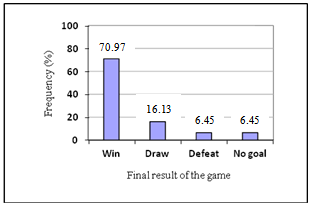 | Graph 1. First’s goal impact in the final result of the game |
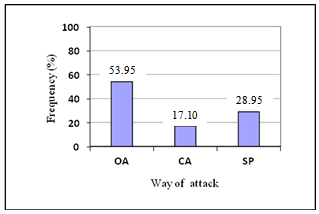 | Graph 2. Way of attack that teams scored goals at Euro 2012 |
|
|
|
4. Discussion
- The data in Table 1 show the goals scored from periods of game (15 min.) and game times (1st and 2nd half). The data analysis of goals scored per game periods showed no significant differences. However, the data showed that 44 goals were scored (57.89%) in the second half of games, proving data found in other studies.In Silva`s study[7], we analyzed 7,599 goals in 2,902 matches, 8 National Championships of Professional Football (Argentine, German, Brazilian, Spanish, French, Dutch, English and Italian), verifying that were scored 44.17% of the goals in first half and 55.83% of the goals in the second half of the matches. In his study, Armatas et al.[8] found out that most goals in women's soccer World Cup in 1995, 1999 and 2003, were marked in the 2nd half of games: 53.5%, 57.7% and 58%, respectively. In the study by Armatas et al.[9], on goals scored in World Cups of 1998, 2002 and 2006, the results showed that most goals scored so well in the second half of games, and scored 60.8%, 59% and 52.5% of goals, respectively. Yiannakos and Armatas[3] in his study on the goals at Euro 2004, found that 57.4% of the goals were scored in the 2nd half of games.According to Gomes et al.[10] the best performance (physical, technical, tactical and psychological) in the football matches is directly linked to physical, i.e., the smaller the physical wear, the better the performance. At the same time that a team early in the game is better able to perform their actions, it will face his opponent with the same conditions. Therefore, the higher incidence of goals in the second half of play may be due to better resistance to decreased physical performance, psychological and technical, and tactical organization of a team, allowing it to stand out over the other. For Reilly[11], the highest occurrence of goals at the end of the match cannot be simply explained by a fall in intensity due to physical wear, as this is balanced, logically for both teams. For the author, the more marked deterioration in performance between the defenders, which gives an advantage to the attackers at the end of the game, and lapses of concentration could be possible explanations.Alternatively, players could be related to a psychological fatigue and a lapse in concentration, more marked as a result of sustained physical exertion, leading to tactical and motor errors, opening the possibility of the goals being converted[12],[13],[11],[14]. Thus, the fatigue, both physical and psychological, in football can manifest itself as a complicating factor, especially at the end of the game, because, according to several studies, a significant number of goals has been scored at this point[15],[16],[11],[17], [13],[18].The data in Graph 1 show the impact of the first goal scored in the final result of the game. According to the data obtained, the team that scored the first goal of the game won in 22 games (70.97%).Armatas et. al.[4] studied the impact of the first goal in the final result of the game in 240 games in the Greek Super League 2006-2007 and found that in 71.43% the team that scored the first goal of the game won. In the study headed by Armatas and Yiannakos[19] the 64 matches of the World Cup 2006 were analyzed, the authors found that the team that scored the first goal of the game won in 73.21% of the games analyzed.According to Armatas and Yiannakos[19] maybe the participation of very weak teams in World Cup but also the deterioration of physical condition of most teams (tournament conducted after all major leagues) resulted in a decrease reaction when a team was conceded goal. More studies should be conducted in order to compare results and to infer conclusions. Theis[20] supported that when a team scored first goal, presents improvement in performance and increased self-confidence. Soccer coach should have his players prepared tactically and psychologically, in order to be ready to face getting back in score. Thus, training should include training matches with different number of players and time limit.Analyzing the way of attack with that the national teams could score goals during the tournament (graph 2), the highest rate was found in OA, with 53.95% of the goals, later, the SB, with 28.95% of the goals, and finally, CA with 17.10% of the goals.In a study that examined patterns of goals in Euro 2004, Yiannakos and Armatas[3] found similar results: OA (44.1%), CA (20.3%) and SB (35.6%). Armatas and Yiannakos[19], in his study of the games of the World Cup 2006, found the following results: OA (47.1), CA (20.3%) and SB (32.6%).As we can see, the SB has a great importance in the modern football due to its high frequency of goals scored. According to Herráez[21], the actions from stopped balls suppose a so valid, spectacular and effective opportunity as any other action of the match. Plenty studies report results that agree with the present study, pointing out the proposition that the percentage of goals scored after stopped balls makes up the 1/3 of the total number of goals scored, irrespective of the tournament (Armatas, Yiannakos & Hatzimanouil, 2007; Armatas, Yiannakos, Papadopoulou & Galazoulas, 2007; Bekris et al., 2005; Fifa, 2002; Jishan et al., 1993; Olsen, 1988; Zempel & Rudolph, 1990 as cited in Armatas & Yiannakos[19]).Armatas, Ampatis and Yiannakos (2005 as cited in Armatas and Yiannakos[19]), emphasize that despite the fact that frequency of counter-attacks in modern football is low (4.9%), they are considered to be more effective than organized attack actions; the following percentages are indicative and support such a proposition: 16.9% of counter-attacks lead to a goal whereas only 11.1% of organized attacks are successful.The table 2, 3 and 4 shows the way of attack through them each team managed to score goal in the first phase, in the second phase and the 4 best classified throughout the tournament, respectively. In Table 4, the data show that Spain was the team that scored more goals during the tournament (12 goals) and also the team that scored more goals through OA (9 goals). Most of the goals of the Spanish team (75%) were scored OA actions, according to the analysis of goals, this high frequency is due to the model of offensive game adopted by the Spanish team, a positional organized attack.Positional organized attack is an offensive action that seeks first, better positioning and geometric distribution in the field, where the ball passes through the horizontal (sideways) ends up being an important part of the strategy of the game (offensive organization), and then, effectively build situations that allow to come to opposing aim and collectively in order to disrupt the opposing defense through the circulation of the ball. Positional organized attack, offensive game model used by the Spanish national team, has as main features:- Attack on compact and homogeneous bloc due to permanent support actions and offensive coverings to players that intervene directly on the ball;- Constant creation of favorable conditions in terms of time, space and number of players in the successive centers of offensive game;- Constant balance of the organization's offensive method due to the systematic use of offensive actions of coverage, of compensation and permutations;- Participation of many players and execution of many technical-tactical actions to achieve the objectives of the attack, thus having a high development in the construction phase of the offending process;- The high time that this method of attack usually lasts can lead the opponents to come into imbalance tactical and psychological, and thus committing to carelessness and mistakes.
5. Conclusions
- Given these results, we can say that the physical performance should directly interfere in technical, tactical and psychological performance of a team, with the highest incidence of goals in the 2nd half of game associated mainly to the drop in physical performance. This clearly shows the importance of physical fitness for good performance of football player during the match, so that he can more quickly achieve their technical and tactical actions, performing well throughout the game without performance drop.Regarding the impact of the first goal for the final game, the physical aspect must also be present. However, among the factors, the psychological aspect seems to be most responsible for the victory of the team that scored the first goal. Most goals were scored by shares organized attack (OA). However, training with stopped balls should have been done due to its significant efficacy in games, 1/3 of all goals scored, regardless of the tournament.With such relevant information, the coaching staff of each team must work the fundamental components of athletes, whether physical, technical, tactical, psychological and / or nutrition, so there is no drop in performance between and not in a state of great fatigue.
 Abstract
Abstract Reference
Reference Full-Text PDF
Full-Text PDF Full-text HTML
Full-text HTML